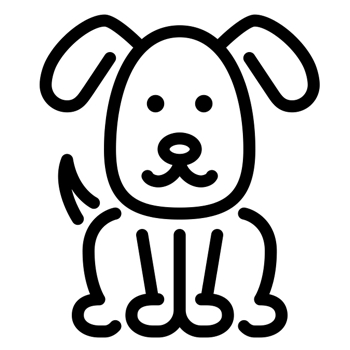Foodle

A cute mixture of the versatile Poodle and the spunky little Toy Fox Terrier, the Foodle is a good choice of pet for an active household with plenty of time to dedicate to training and outdoor activities. Foodles have a natural inclination to be territorial and will always watch over their home and their family, ensuring any stranger that arrives is greeted with a loud chorus of barking.
The Foodle has a diminutive frame and could be classified as a Toy Breed. They exhibit a good mix of physical traits from each breed and are built in good proportion with lean and wiry bodies. Some will have the traditional Poodle fur, though others will inherit a shorter and more wiry coat.
About & History
A combination of the ever-popular Poodle and the American Toy Fox Terrier, the Foodle is a new hybrid breed that is also known as the Foxipoo or Fox Doodle. Established within the United States during the end of the 20th century, this crossbreed is not yet particularly well-known. Typically, it is the Toy Poodle that is used in the mix, making for a small dog indeed. With a history of less than thirty years, we must look to their parents to get a better understanding of this newly established designer dog.
The Toy Fox Terrier
The Toy Fox Terrier is a direct descendant of the British Fox Terrier. Anecdotally, breeders in the U.S. found that the smallest in the litter had the biggest characters and they bred the runts together in the early 1900s to create a miniature version of the Fox Terrier that had an amplified personality. Added to the mix were Chihuahuas and Italian Greyhounds, offering a larger genetic diversity and giving breeders a greater choice.
Many describe the resultant Toy Fox Terrier as a dog with the fiery nature of any Terrier but with a lap dog temperament. Traditionally, these dogs were kept both as companion animals and as vermin hunters. They have also featured in circus acts; their intelligence and cheeky nature making them perfect for the part. Nowadays, they are kept as pets, as well as show dogs and are successful competitors in canine activities, such as agility.
The Poodle
Poodles are a much-loved breed all around the world, coming in three distinct sizes: Toy, Miniature and Standard. Each type is notably different and it is often the smaller two that are used in hybrid creations. As the Poodle is such an all-rounder – attractive, smart and adaptable – they have become one of the most prolific designer dog contributors. Poodles feature in German artwork from as far back as the 15th century, though it was in France that they were popularised and became a big hit with the aristocracy. With a remarkable swimming ability, the Poodle was once used to retrieve water fowl; a job which it is rarely seen carrying out today.
Appearance
The Foodle is characteristically small, measuring between 25cm and 30cm and weighing as little as 4kg to 5.5kg when fully grown. In general, however, the Foodle is not yet very uniform in its appearance and there can be quite a lot of differences even between pups from the same litter. Some will inherit more of the Terrier genes, while others will look more like a Poodle.
The Foodle has dark almond eyes that are well set apart and ears that are set low and hang to the side of their head. They have a reasonably long and narrow muzzle that ends in a sweet, small nose that is always black. Foodles have well-muscled and lean bodies that are rectangular in shape. Their limbs are straight and their back legs can generate a good amount of power. Dogs have a medium-sized tail, which is straight and should not curl excessively over the back.
Fur type is particularly variable with some individuals having tight curls and others developing a wiry, straighter coat. There are several potential fur colours, including white, black, grey, brown and red and many will have more than one colour.
Character & Temperament
As is true of many smaller dogs, the Foodle has a big personality and a temperament that can be feisty at times. They are courageous and will rarely act timid or shy, regardless of the circumstance. Their plucky nature does not mean that they are any less affectionate than other pet dogs and they will form strong bonds with their family, happy to sit on their laps in the evening.
The Foodle can make a good companion to children but is better suited to the company of older children, as their small size makes them prone to accidents if dropped or manhandled. Though the Foodle can accept other dogs, they do not do well in the company of smaller pets, such as cats or rabbits, as the temptation to chase and torment them can often prove too much.
Alert and territorial, the Foodle makes a superb watch dog and will alert their owner to any new arrival with a burst of short and loud yaps. Despite their diminutive size, their inherent bravery means that they can even make successful guard dogs.
Trainability
With ancestors who were used as circus performers, it is little wonder that the Foodle can easily be taught a range of tricks and commands. They are smart, quick on the uptake and have a natural curiosity for the world around them. Trainers will find that they achieve the quickest results when using reward-based training.
Health
With a life expectancy of 12 to 15 years, most Foodles will be healthy dogs that live active and happy lives. However, it is always sensible to monitor the population for any conditions, which may be more likely to develop than in the average canine.
Patellar Luxation
Some dogs will have a knee cap that pops out of its groove and becomes dislocated. This can be a permanent dislocation, or the knee cap may pop in and out every so often. Affected dogs are not able to extend their knee joint properly and can skip when trotting or running. For most, this is a genetic condition and thus breeding animals should be monitored closely for it.
Legg Calve Perthes Disease
In those affected with Legg Calve Perthes Disease, their affected hip joint will begin to disintegrate, most likely due to an improper blood supply. The initial symptoms are subtle and progress gradually.
Over time, the local muscle will atrophy and there will be a noticeable difference when viewing the dogs’ leg muscles on each side. X-rays are sensitive enough to detect this condition. Mild cases are managed medically but more serious cases will require surgical intervention.
Mitral Valve Disease
One of the most common canine cardiac conditions, mitral valve disease is a degenerative disease of the heart valve that gets progressively worse as a dog ages. Vets will be able to detect a heart murmur when listening to the chest with a stethoscope. Modern medicine has meant that a good proportion of affected dogs are managed for several years beyond their initial diagnosis, maintaining a good quality of life.
Exercise and Activity Levels
A failure to satisfy the exercise needs of the Foodle will almost inevitably result in bad behaviours, such as digging, chewing and barking. These dogs need to be kept active and require constant mental stimulation to avoid boredom from setting in. Whilst small, the Foodle comes from working stock and needs at least one solid hour of vigorous and interesting exercise each day. Owners should also vary the activities on offer, which could include scent trails, hide and seek games and agility courses.
Caution is advised if attempting to exercise the Foodle in a public place off lead as their recall tends to get thrown out of the window if they see a tempting bird or squirrel nearby. For this reason, having access to a well-fenced and secure garden is always a bonus.
Grooming
A dog that sheds a minimal amount, some breeders will sell the Foodle as a hypoallergenic breed, although this claim does not always hold up. Depending on their coat type, most will need a brush down with a wire brush about twice a week or so.
The pendulous ears of the Foodle can create an environment within the ear canal that is warm and moist; the ideal place for bacteria and yeast to thrive. To avoid infections from developing, owners are encouraged to dry ears after they get wet and to clean them out using a dog ear cleaner on a regular basis.

